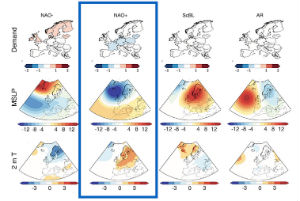Current winter a big win for seasonal forecasts
03 February 2020

Weather forecasting models that correctly predicted mild conditions in northern Europe this winter are being studied in the hope it could lead to improved warnings of future weather.
Seasonal forecasts made by the world’s six leading weather agencies in October for this winter were markedly accurate, with warmer than average temperatures seen in the northern part of Europe, and even record-breaking temperatures in some parts.
Researchers in the Sub-seasonal to Seasonal climate predictions for Energy (S2S4E) project are now analysing why the models were so accurate in order to improve the reliability of early forecasts in future. This would have great benefits to the energy industry, as it would help predict periods of higher or lower electricity demand and the strain on renewable energy sources.
Dr Hannah Bloomfield, a researcher at the University of Reading who is involved in S2S4E project, said: “Modelling work within the S2S4E project has shown that each European country has a very different sensitivity to winter temperatures depending on multiple factors, such as the amount of electric heating installed, or the resilience of the population to cold weather.
“The electricity demand in France is particularly sensitive to temperature, due to their reliance on electric heating. Here, temperatures in December and January averaged 3°C above the seasonal norm, and our models show power demand averaging 6 GW below normal.
“In Sweden, meanwhile, it was about 5°C warmer than normal, and this implies that demand would have been around 2 GW lower than average,” says Bloomfield, adding that “similar results are seen in Norway and Finland”.
The seasonal forecasts published in November for the December-February period, and in December for January-March all showed a clear positive North Atlantic Oscillation (NAO) signal.
Dr Nathalie Schaller, senior researcher at CICERO Center for International Climate Research, and involved in the S2S4E project, said: “This normally translates into warmer and wetter weather than average in Northern Europe, and colder and drier conditions than normal in Southern Europe.
“The record high temperatures in December and January are likely due to a combination of the strong positive NAO phase, and the fact that the earth has already warmed by more than 1⁰C since pre-industrial times.”
Lower than normal electricity demand
The unusually warm temperatures seen in December and January may have resulted in substantial reductions in electricity demand in Europe, due to a reduced need for heating.
It means energy traders who based their decisions on seasonal forecasts will have gained an advantage this winter.
The latest forecasts from the world's six leading weather agencies suggest that a strong NAO phase may remain the dominant circulation pattern in February, March and April, resulting in continued mild weather in large parts of Europe.
Dr Schaller said: “The latest medium-range weather forecast simulations show a similar picture, predicting an almost record positive NAO over the coming weeks, meaning Europe will see more of the same mild weather.”
S2S4E (Sub-Seasonal to Seasonal Climate Forecasting for Energy) is a project funded by the EU's research and innovation programme Horizon 2020, which is working to make long-term forecasts more reliable and useful.
To achieve this goal, S2S4E has developed a new forecasting tool particularly tailored for the energy industry – the S2S4E Decision Support Tool – which is free to use at least until the end of November 2020.
S2S4E is coordinated by Barcelona Supercomputing Center and the 12 partners in the project come from seven different countries in Europe (Spain, France, Norway, Germany, Italy, United Kingdom and Sweden).
For more information about the S2S4E project, please visit the project website.
